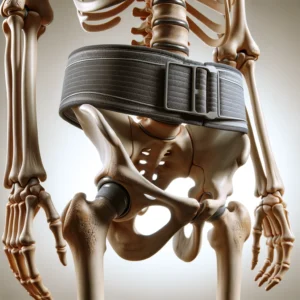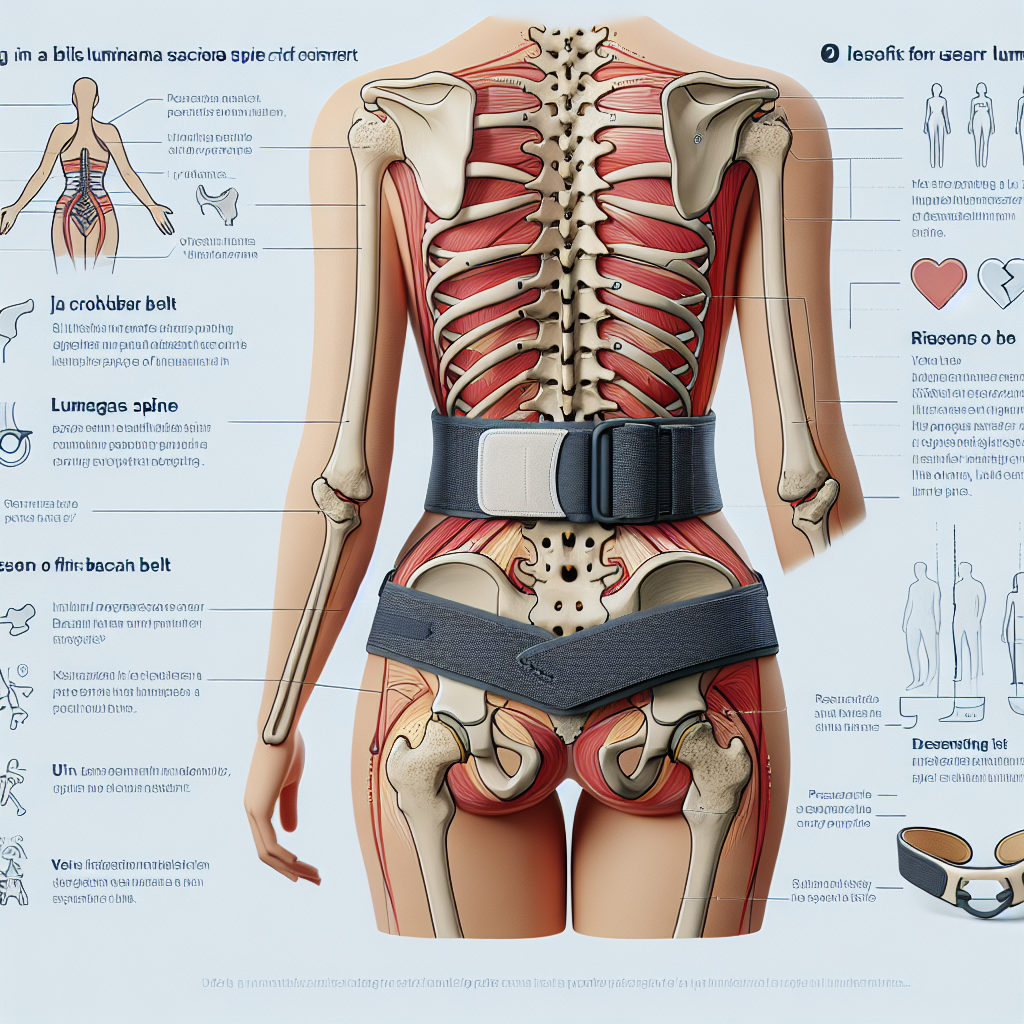
How Can An SI Joint Belt Alleviate Lumbar Spine Discomfort?
If you’ve ever experienced discomfort in your lower back, specifically around the area where your spine and pelvis meet, you’re likely familiar with the frustrations and limitations it can bring to your daily life. But have you ever considered trying an SI joint belt to alleviate that lumbar spine discomfort? This article aims to explore exactly how an SI joint belt works and how it can effectively relieve the pain and discomfort associated with the SI joint and lower back. So, if you’re ready to say goodbye to that nagging ache and hello to a more comfortable life, keep reading to discover the benefits of an SI joint belt.

How Can An SI Joint Belt Alleviate Lumbar Spine Discomfort?
Understanding SI Joint Dysfunction
What is the SI joint?
The SI joint, or sacroiliac joint, is located at the base of the spine where the sacrum and ilium bones meet. This joint plays a crucial role in supporting the upper body and transferring forces between the spine and the lower extremities. It is a synovial joint with limited mobility, but it is still essential for movement and stability.
Causes of SI joint dysfunction
SI joint dysfunction can occur due to various reasons. One common cause is trauma, such as a fall or an accident, which can disrupt the normal alignment and function of the joint. Pregnancy can also contribute to SI joint dysfunction, as the hormones released during this time loosen the ligaments surrounding the joint. Additionally, conditions like arthritis and degenerative joint disease can affect the SI joint and lead to dysfunction.
Symptoms of SI joint dysfunction
SI joint dysfunction manifests in different ways, and the symptoms can vary from person to person. Some individuals may experience pain in the lower back, hips, or buttocks, which may radiate down the leg. Others may have difficulty standing or sitting for extended periods or may feel a sense of instability in the pelvic region. In some cases, SI joint dysfunction can cause imbalances in gait and an altered range of motion.
Diagnosing SI joint dysfunction
Diagnosing SI joint dysfunction can be challenging, as the symptoms can overlap with other conditions affecting the lumbar spine and hips. Healthcare professionals often perform a thorough physical examination, evaluating the patient’s medical history and conducting specific tests to pinpoint the source of pain. Imaging studies, such as X-rays or MRI scans, may be necessary to rule out other potential causes and provide a more accurate diagnosis.
The Connection between SI Joint Dysfunction and Lumbar Spine Discomfort
Anatomical relationship between SI joint and lumbar spine
The SI joint and the lumbar spine have a close anatomical relationship. The lumbar spine consists of five vertebrae, which are connected to the sacrum by the SI joint. Any dysfunction or misalignment in the SI joint can impact the surrounding structures, including the lumbar spine. Conversely, issues in the lumbar spine, such as degenerative disc disease or herniated discs, can affect the stability and function of the SI joint.
Mechanisms linking SI joint dysfunction to lumbar spine discomfort
SI joint dysfunction can contribute to lumbar spine discomfort through various mechanisms. When the SI joint is affected, it can disrupt the normal movement patterns and load distribution in the lumbar spine. The altered alignment and movement can increase stress on the lumbar discs and facet joints, leading to pain and discomfort. Additionally, the compensatory movement patterns adopted by the body to avoid SI joint pain can further strain the muscles and ligaments of the lumbar spine, exacerbating the discomfort.
Common symptoms experienced in the lumbar spine due to SI joint dysfunction
Individuals with SI joint dysfunction often experience lumbar spine discomfort as a result of the interplay between the SI joint and the lumbar spine. The pain may be localized in the lower back or may radiate into the buttocks and down the legs, resembling the symptoms of sciatica. Muscle stiffness, reduced mobility, and a sensation of instability in the lumbar spine are also common. These symptoms can significantly impact an individual’s daily activities and quality of life.
Introduction to SI Joint Belts
What are SI joint belts?
SI joint belts, also known as sacroiliac belts or pelvic belts, are wearable supportive devices designed to provide external stabilization and compression to the SI joint and the surrounding structures. They are typically made of flexible, adjustable materials and feature a secure fastening system to ensure a proper fit. SI joint belts are available in different sizes and designs to accommodate individual needs and preferences.
How do SI joint belts work?
SI joint belts work by exerting pressure and providing support to the SI joint and the pelvis. The compression helps to stabilize the joint, reduce excessive movement, and alleviate stress on the surrounding tissues. By limiting the motion of the SI joint, the belt encourages proper alignment and load distribution in the lumbar spine, which can help alleviate discomfort and promote healing.
Types of SI joint belts available in the market
There are various types of SI joint belts available in the market, each with its unique features and benefits. Some belts wrap around the hips and fasten at the front, while others have additional straps or panels for enhanced support. Some belts are made of elastic materials, offering flexibility and comfort, while others are constructed with rigid components for maximum stability. It is essential to choose a belt that suits individual needs and provides the desired level of support.
Benefits of Using an SI Joint Belt
Reduction of SI joint movement
One of the primary benefits of using an SI joint belt is the reduction of excessive movement in the SI joint. By limiting the range of motion, the belt helps to stabilize the joint and prevent excessive stress on the surrounding tissues. This reduction in movement can provide immediate relief to individuals experiencing SI joint dysfunction and alleviate associated discomfort.
Stabilization of the SI joint
SI joint belts are specifically designed to provide external support and stabilization to the SI joint. The compression exerted by the belt helps to maintain proper alignment and prevent the joint from moving out of position. This stabilization can improve the overall biomechanics of the lumbar spine and reduce strain on the surrounding muscles and ligaments.
Relief from lumbar spine discomfort
The use of an SI joint belt can indirectly alleviate lumbar spine discomfort by addressing the underlying SI joint dysfunction. By stabilizing the SI joint and reducing excessive movement, the belt helps to minimize the strain on the lumbar spine structures. This can lead to a reduction in pain and discomfort in the lower back, allowing individuals to engage in daily activities with greater ease.
Improvement in posture and body mechanics
SI joint dysfunction often affects posture and body mechanics, leading to compensatory movement patterns that further contribute to discomfort. SI joint belts can help improve posture by providing external support and encouraging proper alignment of the spine and pelvis. By promoting better body mechanics, SI joint belts can help individuals adopt more functional movement patterns and reduce the risk of further SI joint dysfunction and associated lumbar spine discomfort.

How Can An SI Joint Belt Alleviate Lumbar Spine Discomfort?
Important Considerations before Using an SI Joint Belt
Consultation with a healthcare professional
Before using an SI joint belt, it is crucial to consult with a healthcare professional, such as a physical therapist or orthopedic specialist. They can evaluate the specific condition and provide guidance on whether an SI joint belt is appropriate and beneficial. Additionally, a healthcare professional can offer recommendations on the specific type of belt and provide instructions on proper fitting and usage.
Proper fitting and adjustment
Proper fitting and adjustment are essential for the effective and safe use of an SI joint belt. The belt should be snug enough to provide support without causing discomfort or restricting circulation. It is essential to follow the manufacturer’s instructions for fitting and adjusting the belt to ensure optimal support and functionality. Regular reassessment of the fit may be necessary as the body changes or the condition progresses.
Choosing the right type of SI joint belt
With various types of SI joint belts available, it is important to choose the right one that suits individual needs and preferences. Factors to consider include the level of support required, comfort, durability, ease of use, and adjustability. Consulting with a healthcare professional or seeking recommendations from individuals with similar conditions can help in selecting the most suitable SI joint belt.
Understanding potential limitations and contraindications
While SI joint belts can provide significant benefits, it is important to understand their potential limitations and contraindications. SI joint belts may not be suitable for everyone, and they may not provide the same level of relief for all individuals. Additionally, specific conditions or injuries may require alternative treatment approaches, and the use of an SI joint belt should be avoided in such cases. It is always advisable to seek professional guidance and individualized recommendations before incorporating an SI joint belt into a treatment plan.
Usage Tips for Maximal Effectiveness
Wearing duration and frequency
The duration and frequency of wearing an SI joint belt can vary depending on the individual and the specific condition. It is important to follow the recommendations of a healthcare professional regarding the duration of belt usage. In some cases, the belt may be worn continuously throughout the day, while in others, it may be used for specific activities or during periods of increased discomfort. Adhering to the prescribed schedule can help maximize the effectiveness of the SI joint belt.
Incorporating exercises and stretches
While an SI joint belt can provide external support and stabilization, it is essential to complement its usage with exercises and stretches to strengthen the surrounding muscles and improve overall joint mobility. A healthcare professional can prescribe specific exercises and stretches that target the SI joint and the lumbar spine. Engaging in a regular exercise program can enhance the long-term effectiveness of the SI joint belt and promote overall physical well-being.
Maintaining proper body mechanics and posture
The use of an SI joint belt should not replace the importance of maintaining proper body mechanics and posture. It is crucial to be mindful of posture during daily activities, such as sitting, standing, and lifting, to minimize stress on the SI joint and the lumbar spine. The belt serves as a supportive aid, but it cannot replace the need for good body mechanics. Regular posture checks and awareness of movement patterns can help to prevent further SI joint dysfunction and lumbar spine discomfort.
Effectiveness in different activities and positions
An SI joint belt can provide support and relief in various activities and positions. It can be particularly beneficial during activities that involve repetitive movements, lifting heavy objects, or prolonged standing or sitting. The belt can also provide support during exercises that place strain on the SI joint and the lumbar spine. However, it is important to communicate with a healthcare professional or therapist to determine the appropriate usage of the belt for specific activities and to avoid potential exacerbation of symptoms.

This image is property of images.pexels.com.
Research Evidence and Expert Opinions
Scientific studies on the use of SI joint belts
Several scientific studies have investigated the effectiveness of SI joint belts in managing SI joint dysfunction and lumbar spine discomfort. These studies have reported positive outcomes, including reductions in pain, improvements in stability, and enhanced functional abilities. However, further research is still needed to establish the long-term effects and identify specific patient populations that may benefit the most from the usage of SI joint belts.
Feedback from healthcare professionals
Healthcare professionals, including physical therapists and orthopedic specialists, often incorporate the use of SI joint belts into their treatment plans for individuals with SI joint dysfunction. Their feedback and clinical experience suggest that SI joint belts can be a valuable part of a comprehensive approach to managing SI joint dysfunction and lumbar spine discomfort. However, they emphasize the importance of individualized treatment plans and the need for ongoing evaluation and adjustments.
Experiences of individuals with SI joint dysfunction
Individuals with SI joint dysfunction have shared their personal experiences with the usage of SI joint belts. Many have reported significant improvements in pain and function after incorporating the belt into their daily routine. They highlight the immediate relief and increased stability provided by the belt, which have allowed them to engage in activities that were previously challenging or impossible. However, it is essential to remember that individual experiences may vary, and what works for one person may not work for another.
Alternative Therapies and Complementary Measures
Physical therapy exercises
Physical therapy exercises are a crucial component of managing SI joint dysfunction and lumbar spine discomfort. A physical therapist can design a customized exercise program that focuses on strengthening the muscles surrounding the SI joint and improving joint mobility. These exercises can be performed in conjunction with the use of an SI joint belt and help address the underlying causes of the dysfunction.
Chiropractic adjustments
Chiropractic adjustments involve manual manipulations of the spine and pelvis to restore proper alignment and function. Some individuals with SI joint dysfunction find relief through chiropractic adjustments, as they can help realign the SI joint and alleviate pressure on the surrounding structures. It is important to consult with a qualified chiropractor who specializes in treating SI joint dysfunction for appropriate adjustments.
Acupuncture and dry needling
Acupuncture and dry needling are techniques that can be used to relieve pain and promote healing in individuals with SI joint dysfunction. These methods involve the insertion of thin needles into specific points on the body to stimulate the nervous system and release tension. While the effectiveness of acupuncture and dry needling may vary among individuals, some find them helpful in reducing pain and improving overall well-being.
Use of heat or cold therapy
Heat or cold therapy can provide temporary relief from SI joint discomfort and lumbar spine pain. Applying heat, such as with a heating pad or warm compress, can help relax tight muscles and increase blood flow to the affected area. Cold therapy, such as using an ice pack or cold compress, can reduce inflammation and numb the area, providing a soothing effect. It is important to consult with a healthcare professional to determine the most appropriate therapy for individual needs.
Supplemental support devices
In addition to SI joint belts, there are other supplemental support devices available that can help alleviate lumbar spine discomfort. These may include lumbar rolls, cushions, or pillows that provide additional support and promote proper alignment during seated activities. These devices can complement the usage of an SI joint belt and enhance overall spine stability and comfort.

How Can An SI Joint Belt Alleviate Lumbar Spine Discomfort?
Potential Side Effects and Precautions
Allergic reactions or skin irritations
Some individuals may experience allergic reactions or skin irritations when using an SI joint belt. This can be due to materials used in the manufacturing of the belt or individual sensitivity. It is important to monitor the skin for any redness, itching, or rashes and discontinue use if any adverse reactions occur. Choosing a belt made of hypoallergenic materials and ensuring proper hygiene can help minimize these risks.
Decreased muscle strength and reliance
Regular use of an SI joint belt may lead to decreased muscle strength and reliance on the external support provided by the belt. It is important to balance the usage of the belt with exercises that strengthen the muscles surrounding the SI joint and the lumbar spine. Maintaining a comprehensive exercise program that targets muscle strength and stability can help prevent muscle weakness and overreliance on the belt.
Dependency on SI joint belts
The use of an SI joint belt should be seen as a part of a comprehensive treatment approach, rather than a standalone solution. Overreliance on the belt without addressing the underlying causes of SI joint dysfunction can lead to dependency. It is important to work with a healthcare professional to develop an individualized plan that includes exercises, lifestyle modifications, and other interventions to address the root causes of SI joint dysfunction.
Avoiding dependency through appropriate usage
To avoid dependency on an SI joint belt, it is important to use it appropriately and in conjunction with other therapeutic measures. The belt should be seen as a temporary aid that provides support during the initial stages of treatment and recovery. As symptoms improve and strength and function are regained, the usage of the belt can be gradually reduced under the guidance of a healthcare professional. The goal should be to achieve long-term stability and pain relief through addressing the underlying causes rather than solely relying on the belt.
Conclusion
SI joint belts can be a valuable tool in managing SI joint dysfunction and alleviating lumbar spine discomfort. By providing external support, stabilizing the SI joint, and improving overall alignment, these belts offer a non-invasive and practical approach to pain relief and improved function. However, it is important to approach their usage within the framework of a comprehensive treatment plan, which may include exercises, posture correction, and other interventions. Consulting with a healthcare professional is crucial for proper guidance and individualized recommendations to ensure optimal results and long-term well-being. With the right approach, an SI joint belt can be a beneficial addition to the management of SI joint dysfunction and lumbar spine discomfort, helping individuals regain mobility, reduce pain, and improve their overall quality of life.







